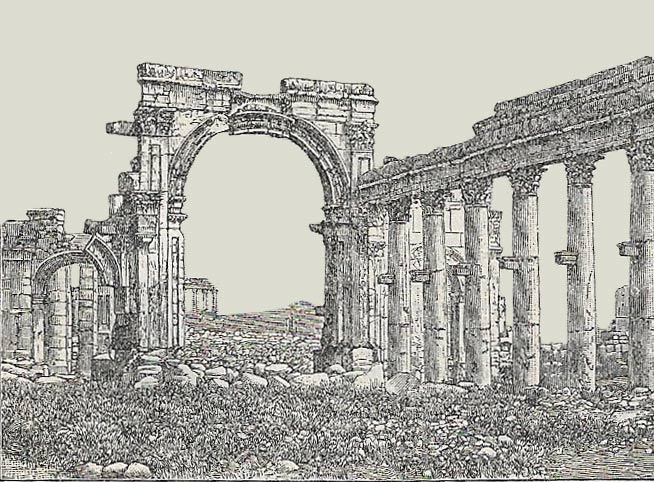Palmyra

Portico of the Great Colonnade, Palmyra
Palmyra, in ancient times, from about 100 AD to the 14th century, more especially in the 3rd and 4th centuries, was a wealthy and magnificent city of northern Syria, situated in an oasis about 150 miles (240 kilometers) northeast of Damascus and nearly midway between that city and the Euphrates. The Semitic name was Tadmor, Palmyra (= "city of the palms") being the Greek and Latin equivalent.
According to tradition it was founded by Solomon. In all probability it was an Arabic settlement, planted at a spot that formed a convenient station on the great caravan route between the Persian Gulf and the Mediterranean. At all events, after the decline of Petra in 105 AD, Palmyra took its place as the chief commercial center in northern Arabia. Its merchant aristocracy brought great advantage from the long-protracted wars between Rome and Parthia by acknowledging the supremacy of Rome. From both Hadrian and Septimius Severus, it received special favors and privileges. One of its chiefs Odenathus, husband of the more famous Zenobia, extended his power over most of the adjoining countries, from Egypt to Asia Minor. Aurelian eventually crushed in 272 the attempt of the Palmyrenes to found an independent empire. After the Roman empire became Christian Palmyra was made a bishopric. When the Moslems conquered Syria Palmyra also submitted to them. From the 15th century it began to sink into decay, along with the rest of the Orient.
Magnificent remains of the ancient city still exist, chief among them being the great temple of the Sun (or Baal); the great colonnade, nearly a mile long, and consisting originally of some 1,500 Corinthian columns;and sepulchral towers overlooking the city. The ancient Palmyrenes, besides conducting and controlling the caravan trade across the desert, extracted salt, tanned leather, and worked in gold and silver.
